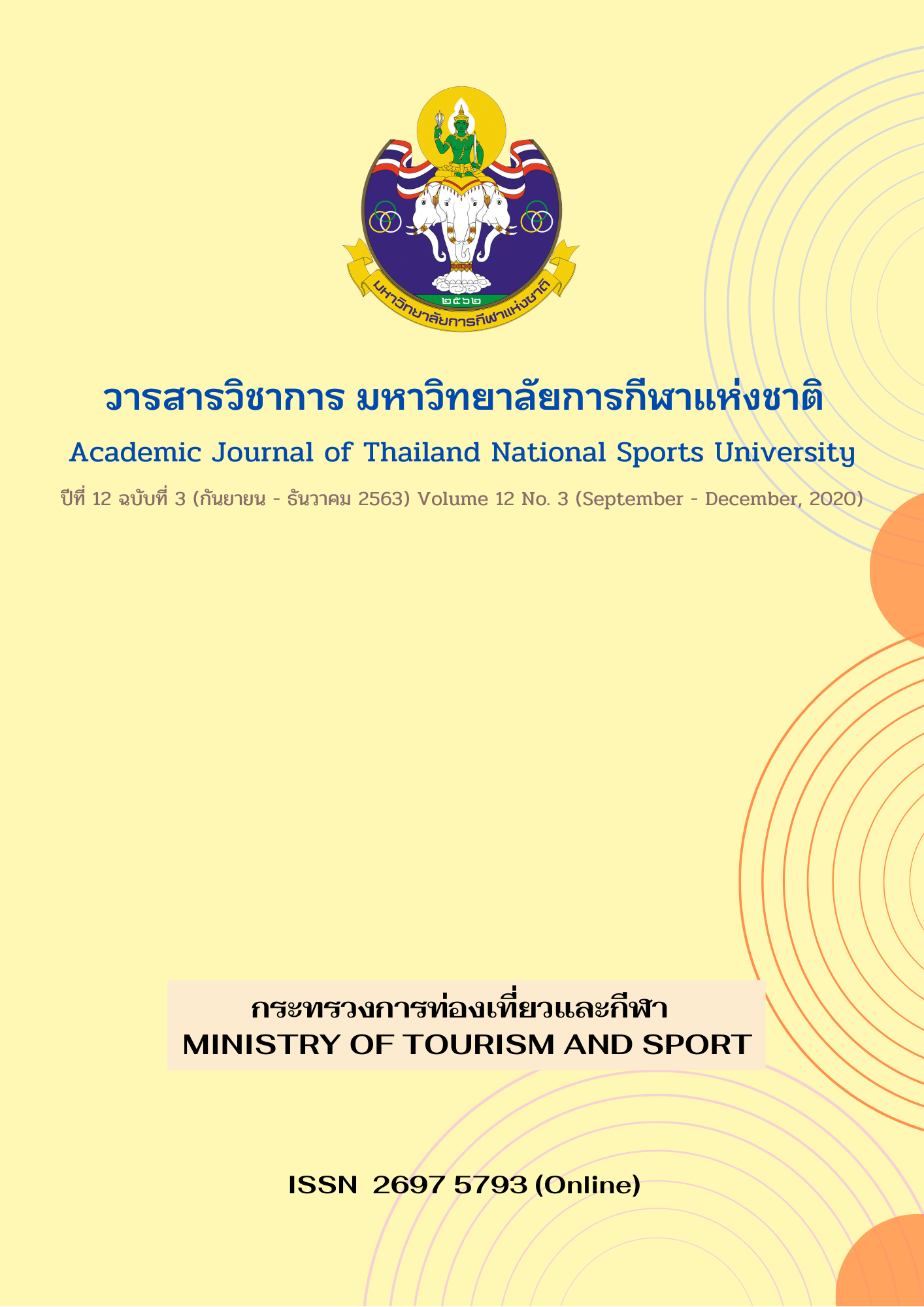SELF-CONFIDENCE AND ANXIETY ON STATE OF NATIONAL SEPAKTAKRAW PLAYERS PARTICIPATING IN THE 18TH ASIAN GAMES IN INDONESIA
Main Article Content
Abstract
This research aimed to study and compare a level of confidence and state anxiety as a whole between situation in relation to gender and ages, as well as to study how to create confidence and reduce anxiety. Participants were 27 national Sepak Takraw players involving in the 18th Asian Games in Indonesia. A purposive selection was used in this study. The Measures of Self-Confidence and Anxiety on State (MSCAS) were used, as well as the content validity and intraclass-and-retest reliability were used in this study. Data analysis was conducted by mean, standard deviation, Paired t-test, Two-and Three-Way Repeated Measure ANOVAs, and Bonferroni which would be used when difference was found.
Results revealed that an overall of self-confidence on state was found at a good level, as well as an overall of anxiety on state was found at a low level. Significant differences were found between situations (p<0.05) but no statistical difference was found between genders and ages (p>0.05). As for, females’ and males’ the top-three-anxiety-reducing techniques most used were meditation, self-talk, and thought stopping. The techniques were used in different ways between genders; females used muscle relaxation and skill training, but males used watching their playing-a-game VDO, playing a game, and watching a cartoon television program, respectively. According to females’ and males’ self-confidence increasing technique most used between genders was goal setting, next was imagery, and the last one was self-arousal technique, respectively.
Article Details
The published article is a copyright of the Academic Journal of Thailand National Sports University. The passage appeared in each article in this academic journal is a perspective of each author which is not related to the journal. Each author is required to be responsible for all components of his/her own article. If there are any mistakes, each author must be responsible for those mistakes on his/her own.
References
Bhasavanija, T., Chirathamawat, P., Chobthamasakul, C., & Poompin, K. (2015). Validation of the Physical and Psychological State Measure in Sport for Thai athletes. Proceedings: The 2nd International Seminar in Exercise and Sport Psychology. Burapha University, Thailand: ISESP.
Bhasavanija, T., & Morris, T. (2013). Using imagery of warmth in competition for oxygen consumption and golf putting performance enhancement. Proceedings: The 13th World Congress of Sport Psychology. Beijing, China: ISSP.
Cerin, E., Szabo, A., Hunt, N., & Williams, C. (2000). Temporal patterning of competitive emotions: A critical review. Journal of Sports Science, 18(8), 605-26.
Hanton, S., Mellalieu, S.D., & Young, S.G. (2002). A qualitative investigation of the temporal patterning of the precompetitive anxiety response. Journal of Sports Science, 20(11), 911-28.
Kittiphat Rungkhamchom & Tirata Bhasavanija. (2017). The physical and psychological states in sport in youth athletes. Academic Journal of Institute of Physical Education, 9(2), May – August, 83-96.
Mellalieu, S.D., Neil, R., & Hanton, S. (2006). Self-confidence as a mediator of relationship between competitive anxiety intensity and interpretation. Research Quarterly for Exercise and Sport, 77(2), 263-70.
Phaphat Kumnung. (2001). State anxiety of athlete participating in the 26th National Youth Game. Journal of Faculty of Physical Education, 13(2), 139-147.
Pichit Muangnapo. (2002). Mental fitness. Thai Sport Pamphlet, 6th Year, 13.
Somchai Kuntotong. (2011). State anxiety of gymnastic athletes in the 39th Nation Games. (Master’s thesis). Srinakharintrawiroj University.
Tirata Bhasavanija. (2017). KIN3111 Introduction to kinesiology research. [Booklet]. Department of Health and Physical Education, and Recreation, Faculty of Education, RU.


